Abseiling (aircraft)
The roping in aviation is the transfer of a person or of an object from an aircraft to the ground by roping .
Abseiling types
Abseiling is usually done from a helicopter . In civil use, people are passively roped down through a winch, they are won. When police or military special units are deployed, however, people are also actively roped down in order to quickly reach a location without having to land the helicopter. There are several types of abseiling.
In principle, all types of dismounting require special training; in Germany this and deployment training are strictly regulated and may only be operated by special forces. The requirements of the employers' liability insurance association are very restrictive and therefore restrict extensive training in the civilian sector.
Winch
In this type, a winch powered by an electric motor is used, which lowers the person on a rope. The hook is attached to a snap hook on the person's belt or on the rescue sling or on the rescue cage. In contrast to abseiling while climbing, the person is lowered passively, i.e. i.e., it does not participate in the process. This possibility of civilian and military organizations to use Search and Rescue ( Rescue / Recovery ) and helicopter transfers; the transfer of personnel at sea as well as in inaccessible terrain. Conversely, it is also possible to lift people or equipment with the cable winch.
Fast roping
Here, thick ropes are lowered from a swing-out gallows , on which the emergency services, one after the other - depending on the length of the rope, three to four people can slide down the rope one after the other - slide down without further safety. These are special ropes that are stranded from many small ropes because of the great frictional heat on the rope surface. The emergency services that slide down wear special gloves or wrap their gloves with adhesive tape, which is then used as a sacrificial layer when sliding down. The rope can be thrown off after the last person has been set down or, if the situation permits, pulled back in again. A Black Hawk can drop 14 men out of both doors in around 30 seconds.
This way of moving the emergency services is particularly used when boarding ships by the Navy , where it is a quick alternative to approaching by boat. In built-up areas, the land forces make particular use of the fact that the helicopter does not have to land during the abseiling process and is therefore on the one hand less exposed to a possible attack and on the other hand retains its maneuverability. The disadvantage of this shipment is the lack of security options.
Speed rappelling
With a special descender, which can be operated with one hand, each person with their own normal climbing rope with a diameter of 10 to 12 mm leaves the helicopter. The running rope can be put in a linen bag on the leg of the descender to prevent tangling. This type of abseiling enables at least six emergency services to be lowered at the same time. After landing, the people have to separate from the rope, the ropes are then dropped from the helicopter.
As with fast roping, speed roping saves time compared to landing and also enables access to places where a helicopter cannot land. The disadvantages of the low abseiling strength of the emergency services are offset by more safety and the possibility of using weapons on the rope.
Special Patrol Insertion / Extraction
The system known as SPIE-rig ( rig English for equipment) is a further development of rappelling by the US Marines. Like fast roping and speed rappelling, it is used to land quickly but also to pick up emergency services from inaccessible places. In this procedure, the soldiers hang on a rope that is attached to the helicopter or tiltrotor aircraft . In civilian terms, this is comparable to a dew removal.
Web links
Individual evidence
- ↑ USMC regulation: FMFM 7-40 Helicopter Rope Suspension Training (HRST) Operations
- ↑ Marine Corps Order 3500.42B. (PDF; 774 KB) Department of the Navy, October 1, 2012, accessed on October 19, 2013 (English, Marine Corps instruction from 2012 on helicopter abseiling training).



